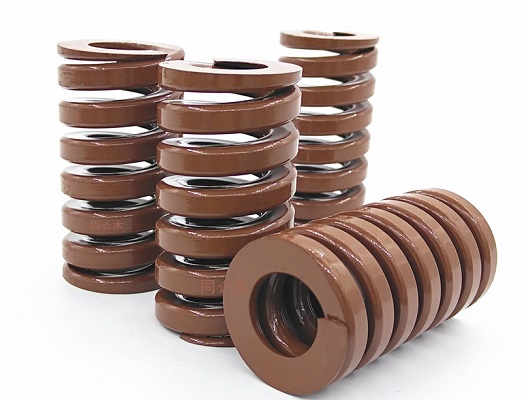Thermomechanical treatment
The combination of deformation strengthening and heat treatment strengthening of steel to further improve the strength and toughness of steel. Thermomechanical treatment can be divided into high, medium and low temperature. High temperature thermomechanical treatment is quenching immediately after deformation in the stable austenite state. It can also be combined with forging or hot rolling, that is, quenching immediately after hot forming. Thermomechanical treatment has been used in the production of automobile leaf spring. (60Si2Mn)

Isothermal quenching of spring
For springs with small diameter or sufficient permeability, isothermal quenching can be adopted, which can not only reduce deformation, but also improve strength and toughness. It is best to temper again after isothermal quenching to improve the elastic limit. The tempering temperature is the same as that of isothermal quenching.
Relaxation treatment of spring
The spring works under the action of external force for a long time. As a result of stress relaxation, a small amount of permanent (plastic) deformation will be produced. Especially for the spring working at high temperature, the stress relaxation phenomenon is more serious at high temperature, which reduces the accuracy of the spring, which is not allowed for general precision springs. Therefore, this kind of spring should be relaxed after quenching and tempering – pre load the spring to make its deformation exceed the deformation that may occur when the spring works. Then heat it under the condition of 20c higher than the working temperature for 8-24h.
Low temperature carbonitriding
the combination of tempering and low temperature carbonitriding (soft nitriding) can significantly improve the fatigue life and corrosion resistance of springs. This process is mostly used for coil springs.
Shot peening
surface defects such as scratches, folding and oxidative decarburization often become the place of stress concentration and fatigue fracture source during spring operation. If the spring surface is sprayed with fine steel shot at high speed, it will not only improve the spring surface quality and surface strength, but also make the surface in a state of compressive stress, so as to improve the fatigue strength and service life of the spring.
Precautions for operation
(1) Before heat treatment, check whether there are decarburization, cracks and other defects on the surface. These surface defects will seriously reduce the fatigue limit of the spring.
(2) Special attention shall be paid to prevent overheating and decarburization during quenching heating, deoxidize in salt bath, control furnace gas atmosphere, and strictly control heating temperature and time
(3) In order to reduce deformation, the charging mode of spring during heating, the form of fixture and the quenching method during cooling.
(4) Tempering shall be carried out as soon as possible after quenching, and the heating shall be as uniform as possible. Rapid cooling after tempering can prevent tempering brittleness and surface compressive stress, and improve fatigue strength.
Quality testing
Before heat treatment
(1) The rolled surface of steel is often the surface after making springs, so there should be no cracks, folds, scars, hair lines, bubbles, interlayer and pressed oxide scale.
(2) Surface decarburization will significantly reduce the fatigue strength of the spring, and the depth of decarburization layer shall be inspected as required.
After heat treatment
(1) The surface of the spring gauge shall be free of cracks, corrosion pits and serious quenching deformation by naked eye or low power magnifying glass.
(2) The hardness and its uniformity meet the requirements. In mass production, it is allowed to spot check the hardness with a file, but it must be noted that the position of the file mark shall not affect the final accuracy of the spring.
(3) The metallographic structure shall be troostite or a mixed structure of Troostite and sorbite.
(4) After the leaf spring is assembled, the permanent deformation under working load and static load deflection test are usually carried out.






